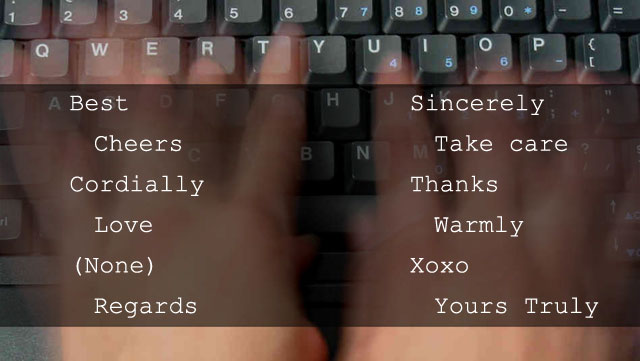I asked some people in my Facebook community a little while ago about how they signed off their emails and whether they had put much thought into the language they used. The question was prompted by an interesting email sign-off I had received the day before: ‘To Higher Conversions, Clay Collins.” He’s the dude who sends me information from Leadpages, the landing page application I use. This sign-off is perfect for him and his business – helping people creating landing pages that convert visitors to customers – and is highly memorable for that reason.
Most of the people who responded to me hadn’t put much thought into their own sign-off. They were simply using the same words they had been using forever – mostly as a layover from corporate days. It got the creative juices flowing – mine and theirs – as to better ways to sign off emails to their clients and prospects.
But why is a sign-off important? Why should we even bother thinking about it? Because how you sign-off or close your email sets the tone for the email and leaves a lasting impression on your reader. It can also make or break the intention, and therefore ‘success’, of your email.
Obviously there are different styles of writing for business emails versus personal ones, and so too should your sign-off be different. There is one thing that EVERY sign-off requires however – your name! Whether it’s first and last or your first name alone depends on the level of formality. Usually the first time you write to someone you will include both your first and surname; subsequent communications will probably only require your first name. And if you’re writing to a close friend or family member you may even use your nickname.
The sign-off itself will also depend on the overall tone you are trying to achieve and also possibly the intended meaning of the email content. For instance, you wouldn’t use “Yours truly” in a business email; it’s too familiar and warm and usually reserved for close relationships. On the other hand you wouldn’t simply use “Regards” if you were trying to build a relationship with someone and sell them your counselling or coaching services! It’s highly unemotional and could be considered terse.
You may like to consider using a sign-off that is reflective of your personality or individuality (“Sparkles and light” if you’re a cosmic cat!). I like to encourage clients to use words that reflects their business value or offering. For example, a naturopath may use “Yours in wellness”. A life coach might use: “To your health and wealth”. A travel agent might say: “Here’s to great adventures.” There are endless possibilities – most of which will be far more meaningful and memorable for your reader, (whilst still being appropriate), than boring old “Regards” or “Best wishes”.
Here are my four rules for signing off on emails:
- Don’t include quotes. They can make the reader question why you’ve chosen that particular quote and therefore prove to be a distraction.
- Avoid oversized logos. If they are too big, they draw the eye away from the message.
- Include your title and contact info, but keep it short. In most business emails, you’re doing the person a favor by sharing your vitals, but keep it minimal. A link to your website or Facebook page is ok but avoid a shopping list of links promoting your projects and publications.
- Include some kind of sign-off, not just your name. The function of a sign-off is to signal the end of a message. It helps direct the reader and clearly communicate your message.
Here is a list of some common and not-so-common sign-offs with a bit of commentary attached!
Best – Totally safe but can be a little lonely on its own.
All the best – This is better and harmless. A good one for a wide variety of recipients.
My best to you – A little old-fashioned.
Best Wishes – It’s a little like a birthday card sign-off from your work colleagues but it’s not bad.
Bests – Too fussy and terrible if you have a lisp!
Best Regards – More formal than “Best wishes.”
Regards – Fine and helpfully briefbut a little dull and not very warm.
Kind regards – Warmer and better than plain “Regards” if you want some formality but are building a relationship. I use this often.
Rgds – OK if you’re sending it from your phone but it wouldn’t kill you to type the other 3 letters!
Warm Regards – I like this for a personal email to someone you don’t know very well, or a business email that is meant as a thank-you.
Warmest Regards – As good as Warm Regards, with a touch of added heat.
Cordially – Very old fashioned and always reminds me of cordial…the drink…from the 70s…
Take care – In the right instances, especially for personal emails, this works. I use this when the email content warrants it.
Thanks – I’m not convinced this is a sign-off as such, but it would depend on the content of the email.
Thanks so much – I use this when someone with whom I have a business relationship has put time and effort into a task or email.
Thank you – More formal than “Thanks.” I use this sometimes.
Many thanks – I use this when I genuinely appreciate the effort the recipient has undertaken.
Thanks for your consideration – Quite formal, but would definitely work in the business context where you are submitting an offer, idea or proposal. Be careful though as it could be seen as almost asking for a rejection.
Thx – I don’t approve of this in emails but in a text between friends and familiars it’s ok.
Hope this helps – I use this one when I am offering solicited advice to help the recipient.
Continued success – You’d want to be sure they had initial success before using this!
Keep up the good work – As above! This can be useful however, if messaging a coaching client who has sought feedback on something from you.
Be well – I find this a bit grating. Not appropriate for a business email.
Peace – Suitable if that’s your business or personality, but pick your audience.
Yours Truly – Very much an old fashioned way to sign off. Think: your 9 year old pen pal or estranged auntie!
Very Truly Yours – VERY VERY old fashioned.
Sincerely – OK for some formal business correspondence, but reeks of lawyers and accountants to me.
Yours Sincerely – Same as “Sincerely,” but even more so!
Looking forward to your reply – This works when you genuinely want a reply from your recipient!
Cheers! – I use this sometimes for familiars. It’s quite a British/Aussie thing. Be mindful of using this with Europeans or Americans.
Have a good one – Again, very Aussie. Be mindful of how this could be misconstrued too. Have a good what???
Ciao – I like this in playful personal emails. But then I love everything Italian!
-Your name – Terse but ok except if it’s an initial email. I’d always try to combine an actual sign-off with your name.
-Initial – Good if you know the recipient really well and even fine in a business context if it’s someone with whom you correspond frequently.
Love – Way too informal in the business context for me. This could be off-putting for some.
XOXO – Not a good idea in business emails. Save the kissses and hugs for your bestie or partner.
Lots of love – Only for personal emails.
Hugs – It’s hard to imagine this in a business email but it’s great when you’re writing to your granny.
Smiley face – Emoticons are increasingly accepted, though some people find them grating. Be mindful that they may reproduce incorrectly when read through some email applications so will appear as [smiley face] rather than the actual picture of a cute little yellow face.
Take it easy – Highly informal and may not be read as intended. Be careful using this with people you don’t know well.
See you around – Same as “take it easy”. Are you literally going to see them around or figuratively?
Sent from my iPhone – This used to bother me but I realise that it can explain brevity and typos (which I hate, regardless of the device being used!). I would prefer people don’t know whether I’m at my desk or on the move, so I don’t use this.
Typos courtesy of my iPhone – No excuses peeps!
Pardon my monkey thumbs – Same problem here.
Please consider the environment before printing this e-mail. – A bit preachy and a bit early 2000s. Who doesn’t know that printing uses paper?
Lengthy disclaimers – We’ve all seen these and ignored them, though I understand that many companies require them.
The final word:
Your closing needs to be inline with the overall tone and demeanour of your email. If it’s completely at odds it will be jarring and will leave the reader wondering what they’re supposed to do or feel next. The sign-off is the icing on the cake to ensure your message is received as intended and there is no room for misunderstanding.
By taking your time to choose your words carefully, your sign-off will become another demonstration of how wonderful it is to communicate with you!



Thanks Jo – great analysis and wonderful food for thought!
Kindly all the bestest,
Julie